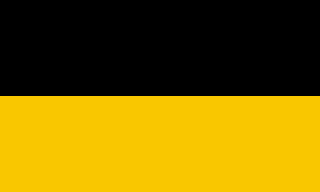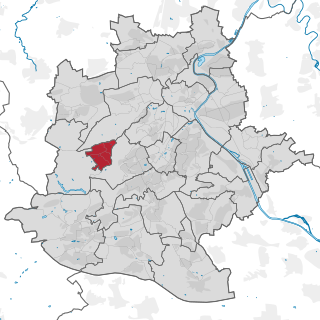
Baden-Württemberg, commonly shortened to BW or BaWü, is a German state (Bundesland) in Southwest Germany, east of the Rhine, which forms the southern part of Germany's western border with France. With more than 11.07 million inhabitants as of 2019 across a total area of nearly 35,752 km2 (13,804 sq mi), it is the third-largest German state by both area and population. As a federated state, Baden-Württemberg is a partly-sovereign parliamentary republic. The largest city in Baden-Württemberg is the state capital of Stuttgart, followed by Mannheim and Karlsruhe. Other major cities are Freiburg im Breisgau, Heidelberg, Heilbronn, Pforzheim, Reutlingen, Tübingen, and Ulm.

Ludwigsburg is a city in Baden-Württemberg, Germany, about 12 kilometres (7.5 mi) north of Stuttgart city centre, near the river Neckar. It is the largest and primary city of the Ludwigsburg district with about 88,000 inhabitants. It is situated within the Stuttgart Region, and the district is part of the administrative region (Regierungsbezirk) of Stuttgart.

Groß-Gerau is the district seat of the Groß-Gerau district, lying in the southern Frankfurt Rhein-Main Region in Hesse, Germany, and serving as a hub for the surrounding area. In 1994, the town hosted the 34th Hessentag state festival.

Horb am Neckar is a town in the southwest of the German state of Baden-Württemberg. It is located on the Neckar river, between Offenburg to the west and Tübingen to the east. It has around 25,000 inhabitants, of whom about 6,000 live in the main town of Horb, and the remainder in 18 associated villages and districts which form part of the same municipality. If the entire municipality is counted, it is the largest town in the District of Freudenstadt.

Geislingen an der Steige is surrounded by the heights of the Swabian Alb and embedded in 5 beautiful valleys. It is a town in the district of Göppingen in Baden-Württemberg in southern Germany. The name relates to its location "on the climb" of a trade route over the Swabian Jura mountain range. It is in the southeast of the Stuttgart region about 50 km of Stuttgart and 27 km of Ulm. It is the second largest city in the district of Göppingen. The city is characterized by a grown industry and attractive surroundings of the Swabian Albtrauf adventure region - this creates a positive environment for regionally and internationally oriented companies. Geislingen's economic significance lies above all in the steel and metal goods processing and automotive supply sectors.

Mundelsheim is a municipality in the German state of Baden-Wuerttemberg. It is located in the Ludwigsburg district, about 30 km north of Stuttgart and 20 km south of Heilbronn, on the Neckar river. It belongs to the Stuttgart Metropolitan Region.

Kirchheim unter Teck is a town in Baden-Württemberg, Germany, in the district of Esslingen. It is located on the small river Lauter, a tributary of the Neckar. It is 10 km near the Teck castle, approximately 35 kilometres southeast of Stuttgart. It is the fourth city in the Esslingen district, forming a district centre for the surrounding communities.

Ditzingen is a town in the district of Ludwigsburg, Baden-Württemberg, Germany. It is located approximately 10 km northwest of Stuttgart, and 12 km southwest of Ludwigsburg. The Hirschlanden transmitter was located near Ditzingen-Hirschlanden. Ditzingen is the home of Bürger GmbH, Reclam and also Trumpf GmbH.

Bad Rappenau (help·info) is a town in the district of Heilbronn in Baden-Württemberg in southern Germany. It is about 15 kilometres (9 mi) northwest of Heilbronn.

Künzelsau is a town in Baden-Württemberg, in south central Germany. It is the capital of the Hohenlohe district. It is located on the river Kocher, 19 km (12 mi) north of Schwäbisch Hall, and 37 km (23 mi) northeast of Heilbronn.

Renningen is a town in the district of Böblingen, Baden-Württemberg, Germany. It is situated 18 km west of Stuttgart.

Zuffenhausen is one of three northernmost boroughs of the city of Stuttgart, capital of the German state of Baden-Württemberg. The borough is primarily an incorporation of the formerly independent townships Zuffenhausen, Zazenhausen, Neuwirtshaus, and Rot, the latter is a historic town that gained importance in 1945 as a refugee camp for German refugees. As of 2009 around 35,000 people lived in Zuffenhausen's area of 1,200 ha (12 km2), making it the third largest of Stuttgart's outer boroughs. Zuffenhausen is also one of the oldest continuously inhabited places in Stuttgart with evidence of permanent settlements that can be traced back 7,500 years.

Wernau is a town in the district of Esslingen in Baden-Württemberg southwestern Germany. It is situated on the Neckar river, 25 km southeast of Stuttgart.

Botnang is a borough of the City of Stuttgart and lies between Feuerbach, Stuttgart-West and Vaihingen.

Königsbronn is a municipality in the district of Heidenheim in Baden-Württemberg in southern Germany. Königsbronn (Koenigsbronn) as an administrative community also includes the villages of Itzelberg, Ochsenberg and Zang. It lies in the Brenz valley within the hills of the Swabian Jura, a landscape shaped by karst (limestone). A spring near the town center is the source of the Brenz, a tributary of the Danube.

Weilimdorf until 1955 known as "Weil im Dorf," is the north-western borough (Stadtbezirk) of the German city and capital of Baden-Württemberg, Stuttgart. Weilimdorf, covering an area of 12.6 square kilometres (4.9 sq mi) with a population of around 30,000, borders the Stadtbezirke of Zuffenhausen, Feuerbach, Stuttgart-West, and the towns of Gerlingen, Ditzingen, and Korntal-Münchingen in the Ludwigsburg district. Weilimdorf became part of Stuttgart in 1933 amidst the hardship of the economic instability of the 30s in Germany. The city district is made up by six Stadtteile: Weilimdorf, Bergheim, Giebel, Hausen, Weilimdorf-Nord and Wolfbusch and is home to an expanding commercial area.

Richard Kallee was a German Protestant pastor.

Feuerbach station is an S-Bahn station in the Stuttgart borough of Feuerbach in the German state of Baden-Württemberg. It is on the Franconia Railway. The station is classified by Deutsche Bahn as a category 4 station and is classified as a haltepunkt (halt) because it now has no operable sets of points.

Stuttgart I is an electoral constituency represented in the Bundestag. It elects one member via first-past-the-post voting. Under the current constituency numbering system, it is designated as constituency 258. It is located in central Baden-Württemberg, comprising the central and southern part of the city of Stuttgart.

Stuttgart II is an electoral constituency represented in the Bundestag. It elects one member via first-past-the-post voting. Under the current constituency numbering system, it is designated as constituency 259. It is located in central Baden-Württemberg, comprising the northern part of the city of Stuttgart.


























